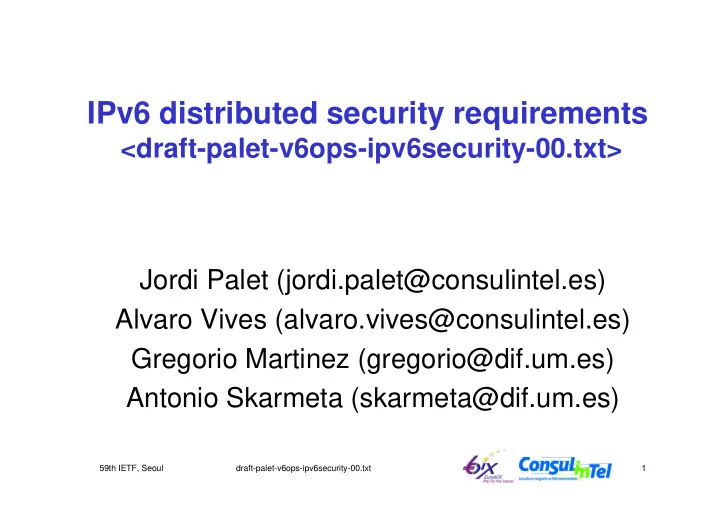

IPv6 distributed security requirements <draft-palet-v6ops-ipv6security-00.txt> Jordi Palet (jordi.palet@consulintel.es) Alvaro Vives (alvaro.vives@consulintel.es) Gregorio Martinez (gregorio@dif.um.es) Antonio Skarmeta (skarmeta@dif.um.es) 59th IETF, Seoul draft-palet-v6ops-ipv6security-00.txt 1
Motivation • Current security policies doesn’t longer apply for end-to-end security with IPv6 – Border firewall = bottleneck • Users and devices start to be “nomadic” – “Static” security setup-ups are a wrong approach • Different visited networks have different security requirements – Manual changes are dangerous – Will not be acceptable for the network manager • Increase in security means increase in processing power – Distribution of security “overhead” could be a solution 59th IETF, Seoul draft-palet-v6ops-ipv6security-00.txt 2
Approach for Solution • Extensive use of “personal firewalls” – Can cope with “interior” security • Personal firewalls should be enabled by default • They should look for a security policy manager in the visited network – Acquire and implement the required local policy – If their processing capabilities are exceeded, then rely on a distributed firewall approach • If IDS are present, the “local” security policy manager can get feedback from it, and suggest security changes to the complete network • Can we cope with virus and spam ? 59th IETF, Seoul draft-palet-v6ops-ipv6security-00.txt 3
Concepts • Attack/Threat: Either passive or active • Security (S): Protection against attacks+IPsec • Policy Management Tool (PMT): Used by the network administrator to edit the policies • Policy Decision Points (PDP): Entity which distribute S policies • Security Policy (SP): Information used by PDP to provide S • Policy Enforcement Points (PEP): Apply S (Clients) 59th IETF, Seoul draft-palet-v6ops-ipv6security-00.txt 4
Actual Security Scheme CLIENTS I NTERNET SERVERS THREAT Security Policy 1 Security Policy 2 PDP 59th IETF, Seoul draft-palet-v6ops-ipv6security-00.txt 5
Distributed Security Scheme CLIENTS (PEP) I NTERNET PDP ALERT DEFAULT SERVERS TRUST ON SEC. POLICY (PEP) THREAT Security Policy 1 Security Policy 2 PDP 59th IETF, Seoul draft-palet-v6ops-ipv6security-00.txt 6
Distributed Security Example HOME HOT-SPOT I NTERNET SP SERVER ALERT OFFICE DEFAULT TRUST ON SEC. POLICY THREAT Security Policy 1 Security Policy 2 PDP 59th IETF, Seoul draft-palet-v6ops-ipv6security-00.txt 7
Recommend
More recommend